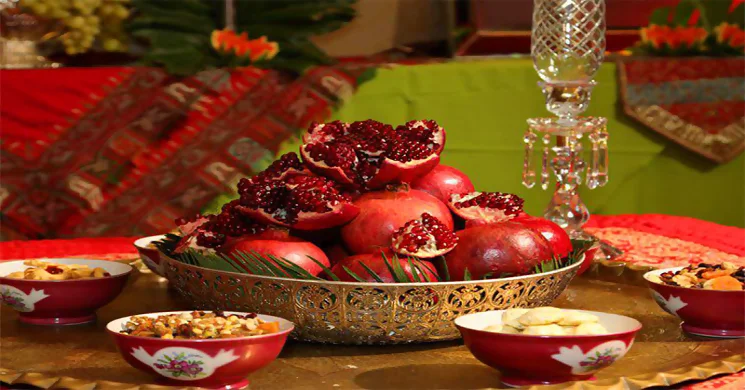
Shab-e Chelle
Shab-e-Yalda or Shab-e Chelle is one of the most ancient Persian festivals annually celebrated by Iranians all around the world. This is one of the most celebrated traditional events in Iran which marks the longest night of the year on the eve of the winter solstice (December 20-21). Today, Yalda celebrations have become a social occasion when friends and family gather to eat, drink and read poetry (especially Hafiz) until after midnight. Fruits, particularly pomegranates and watermelons, and mixed nuts are served in this night. The fruits signify the hope for having a fruitful spring and summer. The red-colored fruits are believed to symbolize the hues of dawn and glow of life, invoking the glory of Mithra.

Chahar-Shanbeh Souri
on the eve of the last Wednesday of the preceding year, as a prelude to Nowruz, the ancient festival of char-shanbeh Souri celebrates Atash (fire) by performing rituals such as lighting bonfires in various public areas and parks, jumping over cinders and expressing “give me your red color and take back sickly pallor” which is a purification ritual and also lighting off firecrackers and fireworks!

Nowruz
Iran’s official new year begins with Nowruz, an ancient Iranian traditional celebrated annually on the vernal equinox. It was registered on the UNESCO’s list of masterpieces. Of the oral and intangible heritage of humanity in 2009 described as the Persian New Year. To celebrate Nowruz there are some preparatory traditions observed by Iranians like khaneh-Tekani, cereal planting, haft-seen, visiting each other, Sizdah-be-Dar.

Haji Firouz
Is a fictional character in Iranian folklore who appears in the streets by the beginning of Nowruz. His face is covered in soot, and he is clad in bright red clothes and a felt hat. He dances through the streets while singing and playing a tambourine.
Haft-seen
Is a tabletop or arrangement of seven symbolic items traditionally displayed at Nowruz, the Iranian new year. The haft-seen table includes seven items all starting with the letter “seen” in the Persian alphabet
Sizdah Bedar
Iranians spend outdoors on the final day of celebrations for the new year holidays. To Iranians the number 13 symbolizes evil and bad luck. The annual “Sizdah Bedar” picnic is based on an ancient Iranian tradition that encourages people to avoid any ill omens at home by going outdoors on the 13th day of the new year. In one of the traditions, young ladies tie together blades of grass in hope of finding their ideal husbands.
Marriage and Persian Wedding
A Persian wedding is huge and extravagant. It’s the biggest Persian celebrate you could attend and it’s very much centered around two families rather than only the bride and groom. Most of its traditions route back to Zoroastrian times and today’s weddings are still keeping many traditional elements.
